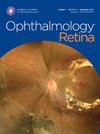Clinical, Genetic, and Histopathological Characteristics of CRX-associated Retinal Dystrophies
IF 4.4
Q1 OPHTHALMOLOGY
引用次数: 0
Abstract
Purpose
To describe phenotypic, genotypic, and histopathological features of inherited retinal dystrophies associated with the CRX gene (CRX-RDs).
Design
Retrospective multicenter cohort study including histopathology.
Subjects
Thirty-nine patients from 31 families with pathogenic variants in the CRX gene.
Methods
Clinical data of 152 visits were collected from medical records. The median follow-up time was 9.1 years (interquartile range (IQR), 3.3–15.3 years; range, 0.0–48.8 years). Histopathologic examination of the eye of a 17-year-old patient with advanced early-onset CRX-RD was performed.
Main Outcome Measures
Visual acuity, retinal imaging, electroretinography, genotype–phenotype correlation, and histopathological examination were evaluated.
Results
The age at onset ranged from birth to the eighth decade of life. Median visual acuity was 1.00 logarithm of the minimum angle of resolution (logMAR) (IQR, 0.69–1.48 logMAR; range, 0.06–3.00 logMAR) at a mean age of 52.0 ± 19.9 years (range, 4.6–81.9 years). Sufficient imaging was available for 36 out of 39 patients (92.3%), and all showed degeneration of at least the macula. Of these 36 patients, 22 (61.1%) had only macular dystrophy. Another 10 patients (27.8%) had additional degeneration beyond the vascular arcades, and 4 patients (11.1%) panretinal degeneration. Two patients (5.1%) had Leber congenital amaurosis. In total, 21 different disease-associated heterozygous CRX variants were identified (10 frameshift, 7 missense, 2 deletion, 1 nonsense, 1 deletion-insertion variants). Missense variants in the CRX homeodomain and 2 variants deleting all functional domains, thus causing haploinsufficiency, generally tended to cause milder late-onset phenotypes.
Histopathologic examination of the eye of a 17-year-old patient with advanced early-onset retinal dystrophy due to a heterozygous deletion of exons 3 and 4 of the CRX gene revealed loss of laminar integrity and widespread photoreceptor degeneration especially in the central retina, with extensive loss of photoreceptor nuclei and outer segments.
Conclusions
This study illustrates the large clinical and genetic heterogenic spectrum of CRX-RDs, ranging from Leber congenital amaurosis to mild late-onset maculopathy resembling occult macular dystrophy. Haploinsufficiency and missense variants tended to be associated with milder phenotypes. Patients showed degeneration predominantly affecting the central retina on imaging. The histopathological findings also mirror these clinical findings and features similar to previously reported animal models of CRX-RDs.
Financial Disclosure(s)
Proprietary or commercial disclosure may be found in the Footnotes and Disclosures at the end of this article.
CRX 相关视网膜营养不良症的临床、遗传和组织病理学特征
目的:描述与 CRX 基因相关的遗传性视网膜营养不良症(CRX-RDs)的表型、基因型和组织病理学特征:设计:包括组织病理学在内的回顾性多中心队列研究:方法:收集来自 31 个家族的 39 名 CRX 基因致病变异患者的 152 次就诊临床数据:从病历中收集了 152 次就诊的临床数据,中位随访时间为 9.1 年(IQR,3.3-15.3 年;范围,0.0-48.8 年)。对一名 17 岁晚期早发 CRX-RD 患者的眼部进行了组织病理学检查:对视力、视网膜成像、视网膜电图(ERG)、基因型与表型的相关性以及组织病理学检查进行了评估:发病年龄从出生到八十岁不等。中位视力为 1.00 logMAR(IQR,0.69-1.48 logMAR;范围,0.06-3.00 logMAR),平均年龄为 52.0 ± 19.9 岁(范围,4.6-81.9 岁)。在 39 名患者中,有 36 名(92.3%)获得了充分的成像资料,所有患者至少黄斑都出现了变性。在这 36 名患者中,22 人(61.1%)仅有黄斑营养不良。另有 10 名患者(27.8%)出现血管弧以外的额外变性,4 名患者(11.1%)出现全视网膜变性。两名患者(5.1%)患有勒伯先天性无视力症(LCA)。共鉴定出21种不同的与疾病相关的杂合CRX变异(10种错义变异、8种框移变异、2种缺失变异、1种缺失插入变异)。CRX同源结构域中的错义变异和两个缺失所有功能域的变异通常会导致较轻的晚发性表型,从而导致单倍体功能缺陷。对一名因 CRX 基因第 3 和第 4 外显子杂合性缺失而导致晚期早发性视网膜营养不良的 17 岁患者的眼部进行组织病理学检查后发现,视网膜板层完整性丧失,广泛的感光细胞变性,尤其是在视网膜中央,感光细胞核和外节广泛丧失:这项研究表明,CRX-RD 的临床和遗传异源性谱很大,从 LCA 到类似隐性黄斑营养不良症的轻度晚发黄斑病变,不一而足。单倍缺失和错义变异往往与较轻的表型有关。成像显示,患者的视网膜变性主要影响视网膜中央。组织病理学结果也反映了这些临床发现,其特征与之前报道的 CRX-RD 动物模型相似。
本文章由计算机程序翻译,如有差异,请以英文原文为准。
求助全文
约1分钟内获得全文
求助全文

 求助内容:
求助内容: 应助结果提醒方式:
应助结果提醒方式:


